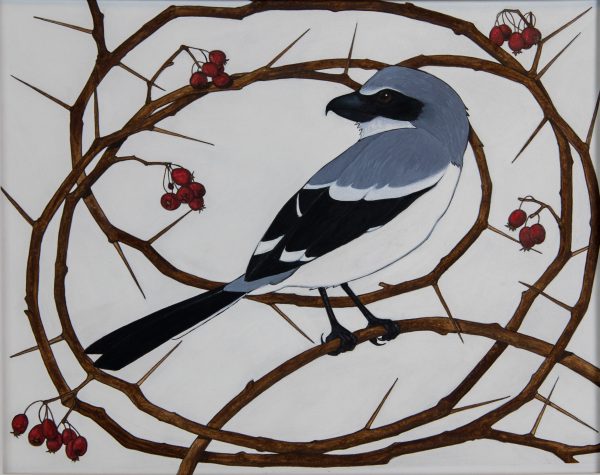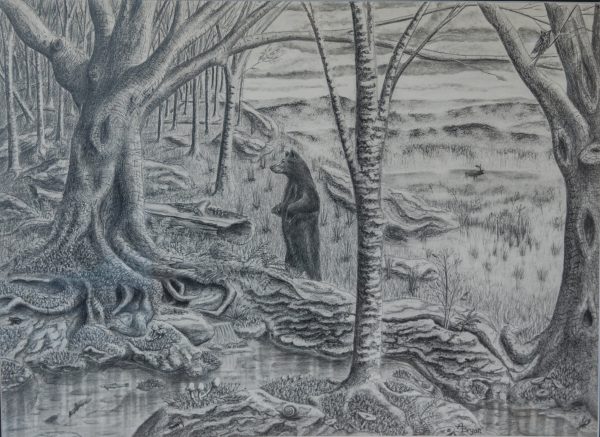The Virginia Department of Wildlife Resources (DWR) is pleased to announce the winners of its annual Restore the Wild Artwork Competition. A panel of judges chose winners in the Fine Art Print, Youth, and “What Restore the Wild Means to Me” categories as the artwork to be used throughout 2022 to help promote Restore the Wild’s mission. The artwork in the Fine Art and Youth categories portray the 2022 Restore the Wild species of focus, the loggerhead shrike, to help draw attention to the bird’s need for expanded habitat.
“We are incredibly thankful to all of the talented artists who took the time to enter the competition—it was a joy to review so many lovely and creative works celebrating loggerhead shrike and other Virginia wildlife,” said DWR Watchable Wildlife Biologist Jessica Ruthenberg from the Restore the Wild committee. “The winning pieces that we ultimately selected stood out not only for their skillful, artistic renderings of their subject species and their habitats, but also for their clear and creative communication of the Restore the Wild theme and its mission. They all illustrate the loggerhead shrike and other Virginia wildlife thriving in their natural, native habitats and that is what it’s all about!”
Virginia Cannici’s watercolor and graphic pencil depiction of a loggerhead shrike topped the Fine Art Print category. Her winning piece will be reproduced as the new art print given as a gift to Restore the Wild’s Golden Eagle level members. “I was inspired to enter the contest when I saw the loggerhead shrike as the subject because I have never heard of this species before,” said Cannici, of Elkton, Virginia. “I did some research online to learn a lot more about them and their habitat. I felt more people should be made aware of this interesting bird and that they are an imperiled species.”

Virginia Cannici – Fine Art Print category winner
Cannici’s son had volunteered for DWR in the trout stocking program and alerted her of the Restore the Wild Artwork Competition. “I myself have not been involved in any conservation work, but as an avid gardener, I try to keep my 10 acres planted with native species that can be beneficial for native birds, animals or insects,” said Cannici. “I am extremely honored to have been chosen the winner of the Fine Art category.”
The winner of the Youth category of the competition, Ava Chiu, expresses her passion for wildlife conservation through her art. Chiu, a high school student from Springfield, Virginia, says she was inspired to enter the Artwork Competition because of the goals of the Restore the Wild initiative, which are to preserve, maintain, and create wildlife habitat. Chiu’s gouache paint piece depicts a loggerhead shrike and its nest in a hawthorn tree. “My inspiration for this piece was ‘protection,’” Chiu said. “It symbolizes the Restore the Wildlife’s mission to protect and restore natural habitats as well as its blooming hopes and journey.

Ava Chiu – Youth category winner
“Due to the declining population, habitat, and increase of threats towards the loggerhead shrike’s habitats, I decided to include thorns and leaves that enclosed the shrike,” Chiu continued. “These thorns and leaves create an intimate, natural protection for the bird. The birds are threatened by habitat loss, depicted by muted fading leaves. However, with DWR’s missions to restore their natural habitats, we hope to protect their blooming future for many generations to come.”
Jessica Wood’s painting of a loggerhead shrike, which earned an Honorable Mention in the Fine Art Print category, also shows the bird in a cockspur hawthorn tree. Her winning piece will be reproduced in a commemorative Restore the Wild sticker given to all Restore the Wild members. “The choice of tree also represents some of the bird’s preferred habitat. The spurs of the hawthorn suggest this fascinating passerine’s habit of impaling prey on thorns for consumption, or as a means of storing food for later,” Wood said.

Jessica Wood – Fine Art Print category honorable mention
Wood, of Crozet, Virginia, is an experienced artist and enthusiastic conservationist. A Virginia Master Naturalist, she has worked with multiple organizations with efforts to plant riparian buffers, clear trails, remove invasive plant species, and assist with stream clean-up efforts such as the Chesapeake Bay Foundation’s Clean the Bay Day.
Al Bryan of North Chesterfield, Virginia, created a piece that depicted “What Restore the Wild Means to Me” and includes a variety of Virginia native species. “I entered the Restore the Wild Artwork Competition in order to heighten awareness for being good stewards of our lands and waterways which sustain flora and fauna as well as our quality of life,” said Bryan, who works as a landscape architect.

Al Bryan – What Restore the Wild Means to Me category winner
The Restore the Wild committee was thrilled to see the quality and variety of entries in this year’s Artwork Competition, which called for submissions from the public that reflect Restore the Wild’s mission to restore and create natural habitats vital to the survival of Virginia’s wildlife. The subject focus of 2022’s artwork is the loggerhead shrike, a state-threatened bird species that has been identified as a Tier 1 Species of Greatest Conservation Need in the Virginia Wildlife Action Plan. Loggerhead shrikes are extraordinary birds that hunt for invertebrate and small vertebrate prey from both natural and artificial perches, including trees, shrubs, power lines, fence posts, etc. They hunt over areas with low grass and bare ground, and impale their prey on thorny shrubs, sharp broken branches and barbed wire. Judges evaluated the works not only on their artistic merit, but also on their precision in illustrating the species’ physical characteristics and habitat, and their adherence to the theme of Restore the Wild.
Virginia has more than 900 species of wildlife whose numbers are in decline mostly because of impacts to their habitat—natural areas that provide necessary food, water, and shelter. DWR is the lead agency in Virginia for the conservation of wildlife and wildlife habitat. DWR’s Restore the Wild initiative allows DWR to expand the work the agency does to preserve, establish, and maintain vital wildlife habitat areas and keep Virginia’s wild places wild. Memberships and donations to Restore the Wild, along with revenue raised with the Run for the Wild virtual 5K run/walk, provide funds directly for DWR habitat projects.
The first two years of Restore the Wild raised more than $75,000 in membership funds, donations, and Run for the Wild registrations. The funds were used immediately to support DWR habitat projects throughout the state, directly benefiting habitat for many species of wildlife. The initiative has funded more than 258 acres of habitat restoration in Virginia. The winning Artwork Competition pieces will be used to help promote Restore the Wild’s mission throughout 2022.
Find out more about DWR’s Restore the Wild initiative and consider becoming a member or making a donation to help restore and maintain essential habitat for Virginia’s wildlife.



